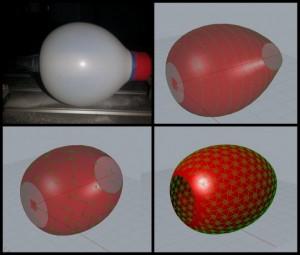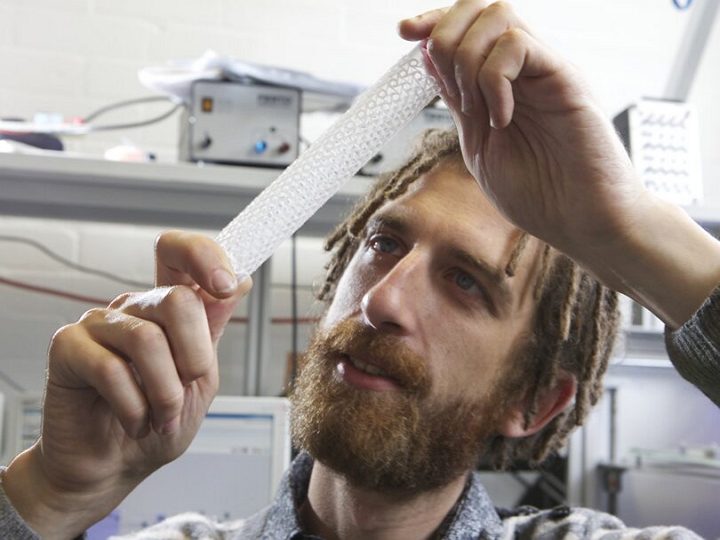Fergal Coulter is a lecturer and PhD candidate at the College of Art & Design and Built Environment at Nottingham Trent University. He has experience in the additive manufacture of tubular, dielectric, elastomer Minimum Energy Structures, cardiac assist devices, auxetic structures, soft robotics and printed electronics.
His latest project, 3D scanning and printing on inflated structures, uses multiple layers of hard silicone – Shore A 73 hardness to be precise – to create seamless, hexachiral structures on an inflated silicone balloon.
 The soft silicone is sprayed onto an air-permeable mandrel which is then inflated and 3D scanned. Those scans are used to calculate geometries for 3D printed forms which are then extruded on to the inflated mandrel using a much harder silicone. The specific geometries being printed are auxetic, ‘hexachiral honeycomb’ structures.
The soft silicone is sprayed onto an air-permeable mandrel which is then inflated and 3D scanned. Those scans are used to calculate geometries for 3D printed forms which are then extruded on to the inflated mandrel using a much harder silicone. The specific geometries being printed are auxetic, ‘hexachiral honeycomb’ structures.
Such auxetic structures have the potential to be used in a wide range of applications from deployable and morphing structures to various medical treatments, soft robotics and artificial muscles.
In this particular case the structures are used to constrain some of the pre-stretch that is imparted in the balloon during inflation. The entire printed structure is to be used in artificial muscles (or more specifically ‘Dielectric Elastomer Actuators’) for in-vivo prosthetics. Rather than using a conventional external actuator of some sort, dielectric elastomers can be made to change form and size through the application of a voltage across a thin rubber membrane. Their efficiency is greatly increased if they are held in a stretched form.
The “auxetic hexachiral structures” can be tailored and tuned for a stiffness response, by varying material hardness, thickness or the tangent angle of the straight line ‘ligaments’.
When the extruded layers of silicone are cured, the balloon mandrel is deflated finally settling into what is termed a Minimum Energy Structure (MES).
Coulter is also working on what are called “smart aortic grafts,” which researchers hope can one day be implanted into a removed section of the ascending aorta to improve the heart’s efficiency. Using “smart materials” that expand when a voltage is applied to them, these origami-esque auxetic techniques can be made to collapse and expand. The idea is that the grafts will create a counter blood-flow by aping the ‘beating’ response of the heart out of phase with the diseased heart. As the heart fills with blood, the woven tube contracts to increase pressure in the heart. When the heart pumps oxygenated blood around the body, the tube is essentially stimulated to expand and release the pressure, thereby increasing blood flow.
The idea is that the grafts will create a counter blood-flow by aping the ‘beating’ response of the heart out of phase with the diseased heart. As the heart fills with blood, the woven tube contracts to increase pressure in the heart. When the heart pumps oxygenated blood around the body, the tube is essentially stimulated to expand and release the pressure, thereby increasing blood flow.
Coulter and his fellow researchers use 3D printing techniques which can be tailored to a patient using MRI scan data.
Working with team leader “Dr Anton Ianakiev, Coulter says the findings are groundbreaking stuff which has the potential to be more effective than current therapies.
Can you think of any applications for this 3D printing on an inflatable substrate technique? Let us know in the Inflatable 3D Printing Substrate forum thread on 3DPB.com.
Subscribe to Our Email Newsletter
Stay up-to-date on all the latest news from the 3D printing industry and receive information and offers from third party vendors.
You May Also Like
3D Printing Webinar and Event Roundup: April 7, 2024
Webinars and events in the 3D printing industry are picking back up this week! Sea-Air-Space is coming to Maryland, and SAE International is sponsoring a 3D Systems webinar about 3D...
Roboze Brings Performance Polymer 3D Printing to SoCal via New Partnership
High-performance polymer 3D printing firm Roboze has been steadily working to expand its global footprint, with a firm eye on distributed manufacturing, particularly with regard to the oil and gas,...
3D Printing Webinar and Event Roundup: March 3, 2024
In this week’s roundup, we have a lot of events taking place, including SPE’s ANTEC 2024, Futurebuild, the AAOP Annual Meeting, JEC World, and more. Stratasys continues its training courses,...
Advanced Manufacturing Firm Zeda Acquires The Orthopedic Implant Company
Zeda, the San Francisco-based provider of advanced manufacturing solutions, announced that it has acquired The Orthopedic Implant Company (OIC), a medical device manufacturer based in Reno, Nevada, for an undisclosed...


































